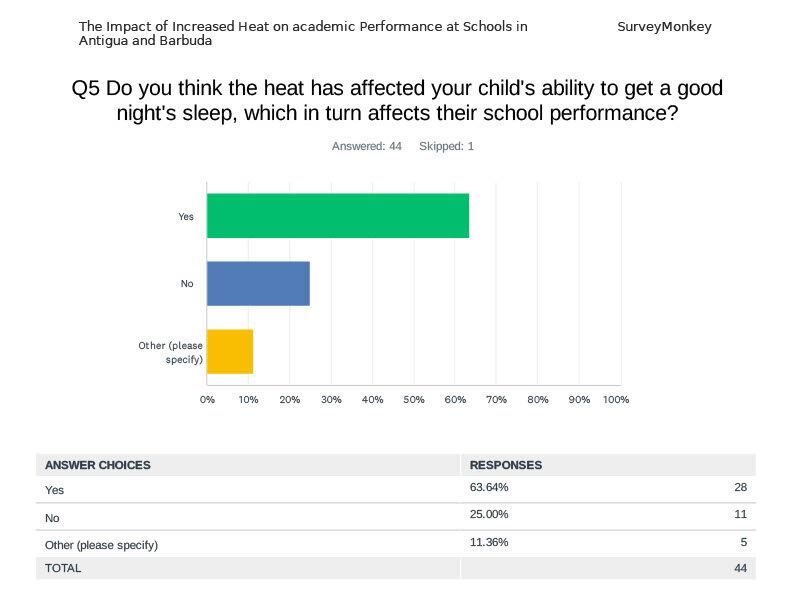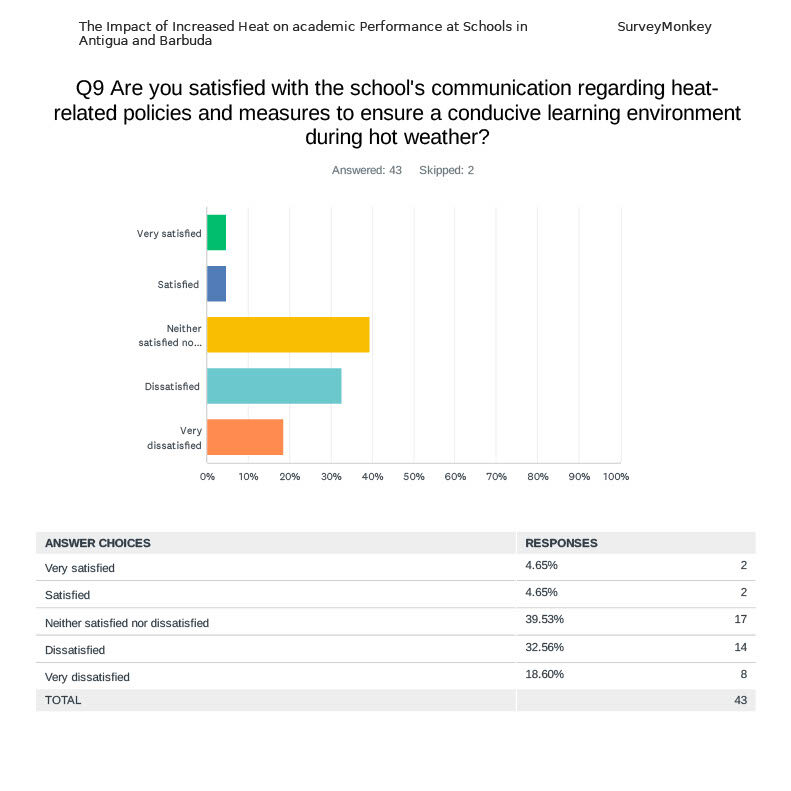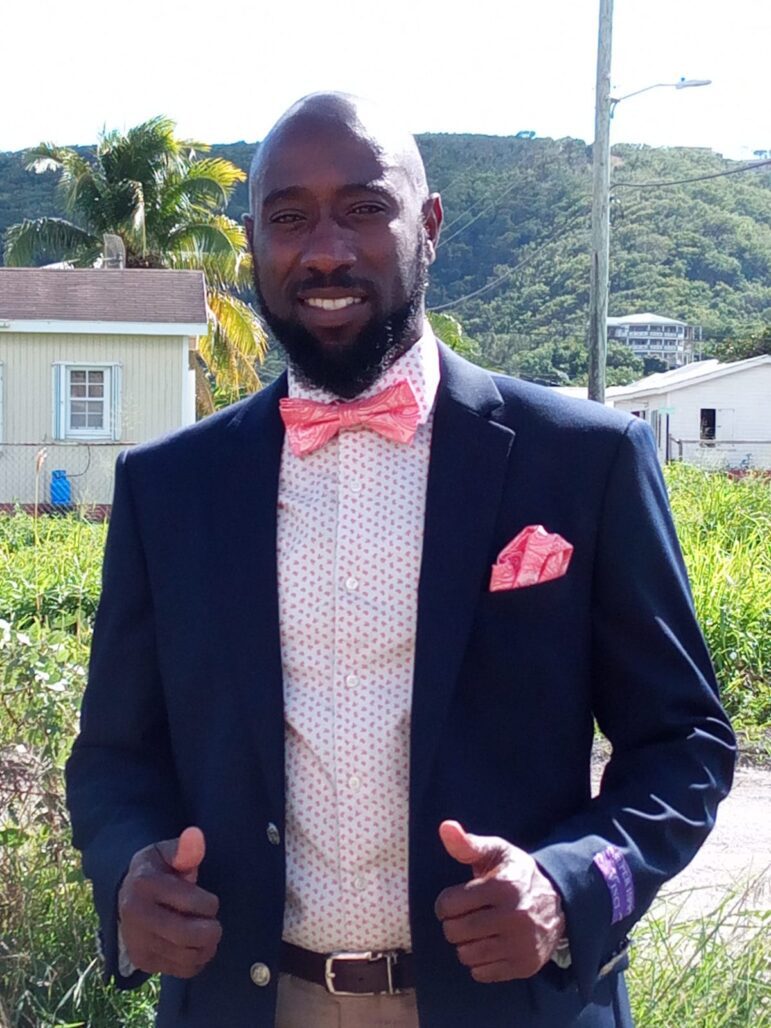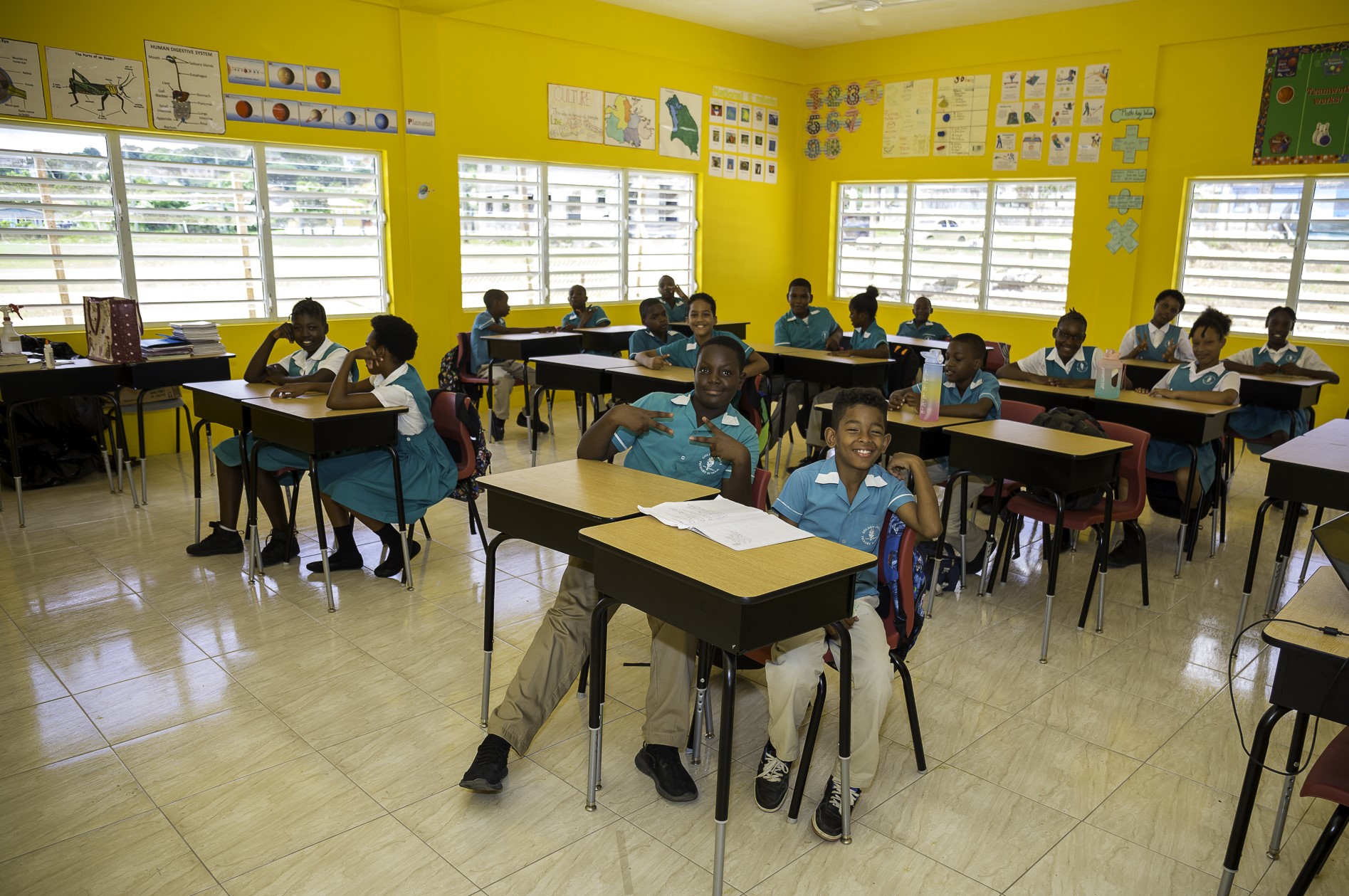Thousands of students who have headed back to school in Antigua and Barbuda since September, are being impacted by severe heat as global temperatures continue to rise. The heat is putting young learners in an environment that is not only uncomfortable but it affects the quality of education they receive.
If they cannot stay focused, they’re not getting that information that is communicated. It affects their ability to perhaps even recall or even do the exams sufficiently because the body is already under pressure to get rid of that heat.
Climatologist, Orvin Paige
Our research found that the heat is not uniformed all across Antigua and Barbuda. Orange Valley and Five Islands tend to record the highest temperatures, creating additional challenges for students in these areas, while Freetown experiences comparatively milder conditions.
According to Paige, a senior climatologist employed by the Antigua and Barbuda Meteorological Services, the month of July marked consistently high temperatures, with maximums hovering around 32 degrees Celsius (approximately 90 degrees Fahrenheit) across most weather stations in the country. The situation escalates as the school year commences in September. “This is where it gets rather crucial between late July and November when we’re dealing with higher relative humidities. If the winds become very light, it could be very catastrophic for our children,” he remarked.
A Heatwave of Unprecedented Proportions
With just two months left until the end of 2023, local climatologists have determined this year to be the hottest on record for the twin-island. As of September 2023, Earth experienced its warmest September on record, with the global average temperature soaring to 61.6 degrees Fahrenheit, a staggering 2.59 degrees higher than the 20th-century average for September, according to data from the National Oceanic and Atmospheric Administration (NOAA). This rise in global temperatures is consistent with a worrying trend of increasing heat that has persisted for several years.
“It is true that [in] the last few years we have seen an upward trend in terms of global temperatures, 2016 and 2020 have tied for the hottest years on record – records going back to perhaps around 1880,” remarked Paige.
While the rise in global temperatures is well-documented, there remains a critical gap in understanding how these conditions impact students in the classroom in Antigua and Barbuda. The absence of specific data on classroom temperatures and their impact on learning has made it challenging to assess the full extent of the problem and how to solve it.
Paige noted, “There is somewhat insufficient data to analyze how specifically a hot classroom affects learning because we do not have a parallel data set to see if students are learning in a cooler environment and how the performances would actually compare. That is perhaps an area for further inquiry and for further discussion even as a project or a pilot.”
In the beginning of July, a Caribbean Regional Climate Center report warned of significantly reduced productivity and reduced learning ability of students at the start of the 2023-2024 school year.
While conventional academic performance indicators may not yet exhibit a significant decline due to the heat, Director of Education, Clare Browne emphasizes the importance of recognizing that students and teachers are being affected. “Though we might not have measured or seen in the student’s academic performance of recent times, any real indicator that the academics would have been affected, we are mindful that it has been affected,” he said.
While the results of National Standardized examinations like the Grade Six National Assessment which assess the performance of Grade 6 students have improved, Browne said ministry officials are cognizant of the adverse impact that sustained temperatures will have in the future. “We are not going to be ostriches and seek to bury our heads under any kind of sand. We know that our students and our teachers are being affected and so the Ministry of Education with the Government of Antigua and Barbuda, we’re seeking to do our level best to create learning spaces that are conducive to the kind of quality education that we want to provide for our children.”
Children Vulnerable to Extreme Heat
With classrooms turning into sweatboxes and students struggling to focus, the lack of comprehensive temperature records in a country notorious for its lax data practices could have life-threatening consequences.
Dr. Shivon Belle-Jarvis, Head of the Pediatric Unit at Sir Lester Bird Medical Centre, emphasized that children are uniquely vulnerable to excessive temperatures compared to adults. Heat exhaustion and heatstroke can have severe consequences, including dizziness, headaches, cramps, excessive sweating, vomiting, and even loss of consciousness. Without proper data collection and mitigation measures, these conditions pose a grave threat to students’ health.
Dr. Belle-Jarvis stressed the urgency, stating, “This definitely is an emergency.”
“It’s very important that each school has an emergency plan in place so that if these signs and symptoms are recognised that the appropriate action is taken.”
“When we look at heat exhaustion for example, the body’s temperature is anywhere between 100 and 104 degrees Fahrenheit and during this time period, as we said for children, they have more difficulty in regulating their body temperatures just because of immaturity. And so you’d find dizziness, headaches, cramps, excessive sweating, vomiting, you may even find that the child looks very pale or feels very clammy and the pulses may start to feel very weak. All of those are signs of heat exhaustion.”
Parents are also concerned about how the heat has been affecting their children. Caribbean Investigative Journalism Network (CIJN) conducted a brief and informal survey asking parents questions about their child’s experience with the heat. It revealed that …. 63.64 % of those who participated felt that the heat affected their child’s ability to get a good night’s sleep, which in turn affects their school performance.

One of the most concerning consequences of the rising temperatures is the noticeable impact on student concentration and attention. As temperatures rise both inside and outside the classrooms, students find it increasingly difficult to focus on their studies. Many students have reported feeling fatigued, irritable, having mild headaches and being less motivated to engage in learning activities.
Most parents responded to the survey saying they are “very concerned” about the impact of high temperatures and heat waves on their child’s overall academic performance and their ability to focus while at school. They report their child becoming frustrated, exhausted and even disoriented. “I have noticed my child’s inability to remain focused,” said one parent.
Based on responses to our survey, more can be done to improve communication between schools and parents who are concerned about how the heat is affecting their child and what is being done at school to mitigate the effects.
Majority – 39.53 % – of those who responded said they were neither satisfied nor dissatisfied with the school’s communication of heat-related policies and measures to ensure a conducive learning environment. The second highest response came from 32.56% of people who said they were dissatisfied.

“As a parent I’ve provided more water for my children. I have encouraged them to stay out of the sun while at school. The challenge Ihave is not being able to monitor them while they are away from me,” remarked a concerned parent.
Teachers and Students Struggle in Hot Classrooms
Teachers, already grappling with the challenges of adapting to new teaching methods in a post-pandemic world, are now facing additional hurdles due to the scorching heat. Some educators have reported that their ability to complete lessons as planned has been severely affected. Extended exposure to high temperatures in classrooms has left both students and teachers feeling drained and less productive.
Robyn Joseph-Nathaniel, First Vice President of the Antigua and Barbuda Union of Teachers, shared her perspective: “Sometimes even as teachers, you become restless because you are hot as well, and it’s weird because you want to achieve your objectives in the lesson, but you also understand that the children are uncomfortable. When they are uncomfortable, it makes it very difficult for instruction to happen effectively. They’re going to miss gaps. They’re going to miss what is being said because you’re hot.”
Teachers say the children are not concentrating and have become restless on hotter days. Complaints from teachers suggest that heat waves have a noticeable impact on students’ classroom engagement, participation, and overall learning.
The collective responses of parents indicated many students become exhausted after lunch, parents said, students become unwilling to actively engage. Parents said they often appear drained, lethargic, and irritable, likely due to wearing uniforms throughout the day. This leads to changes in their engagement levels, making them more inattentive and restless. Students may even undress themselves in an attempt to cool down, which can be distracting and disruptive.
According to the parents, the heat makes them move at a slower pace and they frequently complain of feeling hot and thirsty, some even experience dizziness. This results in decreased focus, disorganization, and sluggish task completion. Many students request breaks to purchase cold beverages or use the restroom due to excessive drinking.
Physical Education classes have been especially affected by the oppressive heat, with teachers finding it increasingly difficult to conduct outdoor activities.
Sean Samuel, Education Officer in the Ministry of Education responsible for Physical Education and Sport, emphasized the need for new approaches. He acknowledged that while the belief that “we were designed for the sun” held in the past, the recent extreme heat necessitates adjustments.
“As black people we always felt that we were designed for the sun and we can’t get burnt and so things like sunscreen and so on are things that are not part of our vocabulary but with this type of heat, it is going to be part of the tools that we never used before, that we [will] have to implement especially when going outside,” he stated.
Many school buildings lack artificial cooling systems like air conditioning, which makes the situation even more challenging. “So, it’s going to be a challenge initially because we’re accustomed to just putting in some roof fans and the good trade wind that comes through gets spun around and it cools you off but with the breeze itself being hot, now that creates another issue that you’re circulating hot air.”
A guide has been developed and circulated to public schools on the island on how they should address the heat-related issues. These guidelines include how to recognize and manage heat exhaustion, as well as ensuring that students remain hydrated.
In terms of physical education activities, a separate document encourages teachers to provide students with cooling breaks every 10 minutes. “So, with 10 minutes the core temperature would not get too hot and so after that point you take them out of the direct contact with the sun so they can cool down and it also prevents them from excess sweating.”
“So, with 10 minutes it kind of cushions the amount of fluids that the students would lose while at the same time not allowing the skin to have that long length of contact with the direct sun thus to cause blisters, burns and that sort of thing.”
On extremely hot days, the guidance suggests avoiding direct sunlight and conducting low-intensity activities in shaded areas within the school. This approach aims to ensure that physical education continues without exposing children to health risks associated with prolonged sun exposure.
“We don’t want physical education to stop at all. What we have suggested is days, when it’s extremely hot, do not take the children out to the direct contact of the sun. Find a shaded area in the school and do the activities there. On those days. we’re also asking that you not rigorous, physical activity but more low intensity activities – ring-around-the-rosie, here comes Jacky – those kinds of little ring games and so on which would not take a lot of energy but at the same time the children enjoy themselves in the shaded area and still get something out of their physical education session.”
Samuel also recommends that schools review uniforms to allow students to wear hats and clothing that attract less heat. Rescheduling the times of sporting activities may also be necessary to mitigate the impact of the heat, he noted. “There are some sports that just a shift in time will suffice, athletics for example. If you are doing track events you now look between 8 in the morning and 6 in the afternoon to say “I’m not going to have my sports day for example, I’ll wait until the sun goes down.”
Change also requires a bit of creativity, he noted, suggesting rehydrating fluids and using cold rags in the absence of air conditioning.
Solutions Present Problems of Their Own
To combat the intense heat, numerous schools have resorted to using standing fans in classrooms. While the intention is to create a more bearable environment, this solution has its drawbacks. Some students find the fans distracting, and the noise they generate can disrupt the learning experience.
One parent weighed in on the matter, stating “Because of the intense heat a lot of schools have turned to using standing fans in the classrooms which sometimes distract students or are too loud at times.”
Others commented: “The classroom is hot and my child can not concentrate when she is uncomfortable”; “Last year around this time there was a drop in his grades but once the weather got cooler, they went back up”; “My children are very drained and exhausted from the heat. They are more dehydrated than usual and it causes them to focus less”; “My child would speak about how hot the day was instead of telling me about the lessons.”
Parents all want air conditioning units to be installed but have offered other suggestions in the interim. Several parents suggested introducing a hybrid approach where students attend school during hours of the morning and continue their lessons at home via remote means or printed work. Extra fans, giving water breaks more often and having classes outdoors as much as possible were also suggested.
Aging Infrastructure and Limited Resources
A solution to this excess heat inside and outside of classrooms will cost the government of Antigua and Barbuda millions of dollars. The root of the problem lies in the aging school infrastructure on the islands. With most schools being built 50 years ago, they lack modern amenities and climate control systems.
“My concern would be where we’re going to get the money to put in the type of things we need to put in. If you notice, most of our infrastructure that we have, sporting infrastructure, none of them have an artificial cooling system, all is by natural air. Now, if the natural air is hot already, then you have to come up with a mechanism to cool that air, to make not only the patrons but the players who will be taking part at these activities comfortable,” Samuel said.
Retrofitting these schools to cope with rising temperatures would require a significant financial investment, which the Ministry of Education currently does not have at its disposal. “I know that we’re looking at millions of dollars”… “The cost of just acquiring the equipment alone will run us into millions of dollars, much less to be retrofitted,” said education director Browne.
Based on price estimates, provided by Itajah Simmons, a mechanical engineer in the Ministry of Energy, to purchase ac units for the 39 public schools across the country, would at minimum cost EC$655,200. ($2800 per unit x 6 classrooms x 39 public schools).
He explained that “The price of a small ac – 12,000BTU – would cost about $1,800 – $2,200. The larger units – 18,000 BTU and 24,000 BTU (the more common ac)- would range in price from $2,800 to $3,800 for the unit.”
Browne estimates that each classroom may need at least two ac units. Many schools, he said, have 21 classrooms in total. Based on this calculation, the total minimum purchase price of the most commonly used units is approximately $4.5 million. ($2800 per unit x 2 per classroom x 21 classrooms x 39 public schools)
“Installation depends on the size of the ac – the smallest may cost between $700-$800 for installation while the larger units may cost between $900 to $1,000.”
Simmons, who designs air condition systems for commercial and residential buildings says knowing which type of unit to install would depend on several factors including the size of the space, how many individuals would be using the space, and how closed off the space is.
Importantly, he said, “We have to do what you call a heat load calculation. So, the heat load calculation helps you to determine what size of air conditioning unit you would need to meet your cooling needs.”
It’s Not as Simple as Just Buying Some Air Conditioners
According to the education director, the Facilities Manager in the Ministry of Education has completed the structural assessment of school plants but is working on assessing the electrical grid of these schools and their capacity to energize these ac units. “Many of our schools, I’m told, strange enough, are wired in a domestic kind of way. So to get there and put three or four conditioned units in each classroom, in a school of 21 classrooms..you could see the kind of impact it would have on the electrical situation.”

The wrong wiring, Simmons said, could overload the school’s electrical system. “A lot of times or sometimes even some of these commercial buildings are wired to take certain loads. So in the breaker box that controls the circuit, it wasn’t sized to take a particular type of load. Therefore you can also cause overloading on the system. So you have to revise your electrical design so that you can determine how many air condition systems you can put onto the system. “
Apart from installation, the government would need to budget for maintenance at least every three months. ”Maintenance falls based on the usage … ac units installed in classrooms that run from 8am to 4pm everyday would need to be maintained every three months on average and cost roughly $150 to 200 per unit.”
They would also need to account for higher energy consumption which means higher electricity bills.
Director Browne said it is up to the Cabinet of Antigua and Barbuda to resource the public sector and so, it is through the Cabinet that the ministry will go. “The Minister will go to the Cabinet to seek the necessary resources. Whether the Cabinet is going to turn to grant funding, whether they’re going to look to donations, then we will have to find creative ways of dealing with this. At the same time I would have made an appeal to corporate society to adopt a school.
“Where we’re trying to get to, is to have all our classrooms, all our schools air conditioned. .. That is the ultimate objective. .. Ours is still a small island developing state with limited resources, finite resources and so, I’m not suggesting tomorrow we might wake up and find all our classrooms air conditioned but we’re looking at it,” he said.
Unprecedented Heat Waves Demand Action
During the summer break, the Antigua Met Office issued at least five excessive heat warnings, stating that temperatures are likely to feel over 100 degrees Fahrenheit for days at a time. Since school began in September, the warnings have continued with temperatures forecast to feel as hot as 104 degrees Fahrenheit for days on end.
According to Paige, “ We’ve seen some pretty high temperatures as early as March and April of this year, long before the heat season is in earnest. And so we are looking at some changes in terms of the patterns. We at the Met Office are committed to monitoring these patterns but we don’t need to be experts to know that this year has been an extremely hot year.”
Based on the latest heat outlook, October marks the last month of the Caribbean Heat Season and is forecast to be even warmer than usual with intense night-time and daytime heat prevailing, possibly extending into early November. It anticipates that islands in the Lesser Antilles like Antigua and Barbuda will experience 8 to 14 heatwave days in October.
The current situation in Antigua and Barbuda highlights the urgent need for data collection on heat and climate-related issues and calls for immediate action. Piage said, through the Met office, he is conducting some research on heat waves dating back to the last several decades. He wants to identify how many heat waves Antigua and Barbuda has experienced and possibly link them with fatality records at the hospital. “You’re not going to see on a death certificate – heat stroke – you may see a heart attack, you may see a stroke but what the medical professionals, those I’ve interacted with are really saying, heat could be the catalyst to bring the body under stress.”
The impact of climate change on the education sector is increasingly undeniable. Small Island Developing States (SIDS) like Antigua and Barbuda are experiencing the most crippling effects of that. A compromised education system reaches far beyond the classroom. Without quality education, Antigua and Barbuda cannot produce the young leaders needed to take this country into the future. More, now than ever, climate change financing will be critical in the future.
Today’s leaders must be ready to commit their own resources and seek international help if need be. Everything is needed: raw data, analysis and solutions that will work to everyone’s benefit.
